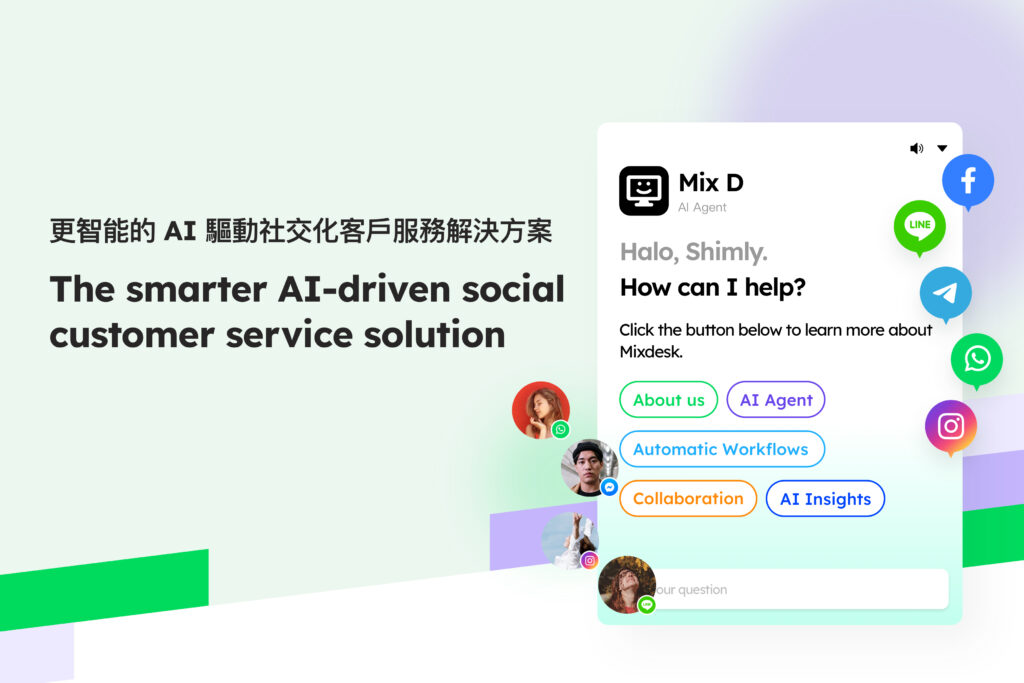Author of this article:Miya, Search engine optimization expert
Abstract: With the rapid rise of cross-border e-commerce, customer service efficiency and customer experience have become key elements in brand globalization competition.
AI customer service tools are gradually replacing traditional manual customer service, showing powerful capabilities in multi-language, multi-time, and high concurrency scenarios.
This article will focus on “AI customer service tools commonly used across borders"Launched, combining search trends and market research, comprehensively analyze the current mainstream AI customer service tool types, application scenarios, core technologies, and representative products, and conduct forward-looking research and judgment on future development trends to help cross-border enterprises build a more efficient global service system.
Mixdesk
AI Agent

- 1. Why do cross-border e-commerce companies urgently need AI customer service?
- 2. Panoramic comparison of cross-border AI customer service tools
- 3. Traditional customer service VS. AI customer service tools
- 4. Typical application scenarios and business value
- 5. The improvement of the customer service experience of AI customer service tools commonly used across borders in the evolution of AI technology
- 6. Suggestions for choosing cross-border AI customer service tools
- 7. Conclusion: AI empowers cross-border customer service and moves towards a more efficient global delivery capability
1. Why do cross-border e-commerce companies urgently need AI customer service?
- The cost of customer service is high, and the manual mode is unsustainable.: Cross-border customer service often faces the challenges of multiple languages, multiple channels, and multiple time zones. Manual scheduling is difficult, response is slow, and training costs are high. It has become a common pain point for overseas companies.
- Customer expectations have increased, and the requirements for “instant” and “consistent” service are higher.: Modern consumers have become accustomed to the efficient service standards shaped by leading brands such as Amazon and Apple on a global scale. This kind of ”educated experience expectation" is forming a reverse force for small and medium-sized brands.
- AI capabilities are maturing rapidly, forCustomer service automationProvide a realistic path: The application of large models such as GPT has allowed AI customer service to move from “script-driven” to “understanding-driven”. It has advanced capabilities such as context retention, emotion recognition, and automatic learning, which provide a solid support for the landing of cross-border scenarios.
2. Panoramic comparison of cross-border AI customer service tools
- Zowie
A plug-and-play AI chatbot for e-commerce that automatically recognizes and processes emails and chat inquiries, suitable for small and medium-sized DTC brands to quickly go online. - Zendesk AI
Support email, chat, telephone, social and other channels, withGenerative AI suggestion reply, Automatic classification of work orders and other capabilities, suitable for large and medium-sized enterprises that need deep access to CRM. - Yellow.ai
It supports 135+ languages and 35+ channels, has speech recognition and NLP capabilities, and is suitable for multi-lingual and multi-platform global brands. - Gupshup
Focusing on WhatsApp, Messenger, SMS, RCS and other message channels, it supports the construction of LLM-based chatbot, which is suitable for enterprises that pay attention to private domain operations. - MixDesk ✅
Built on GPT-4.1Cross-border intelligent customer service system, Designed for overseas brands, support Facebook, Instagram、WhatsApp, Messenger and other mainstream platform message aggregation management.- Automatic translation and semantic understanding of multiple languages: Support multi-language switching and two-way translation in real time.
- Multi-modal recognition and content generation: Support picture, speech recognition and automatic text reply.
- Automatic response and bulk marketing capabilities: Combine rules and AI hybrid strategies to automatically undertake high-frequency customer interactions.
- System docking and deep integration: Flexible docking with ERP, CRM, Shopify, independent stations and other business systems.
- Uniphore
With voice interaction as the core, it has emotion recognition and real-time prompt capabilities, and is suitable for large-scale customer service centers based on voice. - Tidio / Re:amaze / Smartsupp
Lightweight tool, suitable for small and medium-sized cross-border independent stations, with basic functions such as chat, automated FREQUENTLY asked questions, and behavioral triggers.
|Related reading|
3. Traditional customer service VS. AI customer service tools
As the pace of overseas business accelerates,Traditional manual customer serviceThe limitations of cross-border AI customer service tools are gradually exposed, and the AI customer service tools commonly used across borders have gradually become the key engine for cross-border enterprises to “improve efficiency and reduce costs”. The following table compares the performance of the two in the core dimensions:
| Comparative dimensions | Traditional customer service system | AI customer service tools (represented by MixDesk, etc.) |
|---|---|---|
| Response speed | Relying on manual operation, there is a delay | Real-time response, automatic response 7×24 hours a day |
| Language support | Multilingual, multilingual customer service needs to be recruited, and the cost is high | Support automatic translation, covering 100+ languages |
| Processing power | Limited simultaneous processing, low multitasking efficiency | Process thousands of messages concurrently, without fear of peak periods |
| Channel management | Multiple platforms need to be switched repeatedly, easy to make mistakes and omissions | Aggregate mainstream platforms such as Facebook, WhatsApp, IG, Messenger, etc. |
| Data utilization | The data is scattered, making it difficult to form a customer portrait | Structured precipitation of session data to support follow-up analysis and remarketing |
| Labor cost | High cost of recruitment and training, easy to lose | Reduce manpower dependence and automatically handle standardization consulting |
| Emotion recognition and guidance | Lack of judgment of customer emotions and speech strategies | Partial support for emotional analysis and personalized speech generation |
| On-line cycle and extensibility | The system construction cycle is long and the extensibility is limited | Cloud deployment, fast on-line, flexible adaptation to business changes |
🔍 comment:
Traditional customer service systems have difficulty supporting fast and iterative cross-border business in terms of information processing, efficiency control, and global delivery capabilities. The AI customer service tools commonly used across borders, especially intelligent customer service platforms like MixDesk that focus on cross-border social ecology, have become an indispensable service engine for brands in the process of going overseas.
|Related reading|
4. Typical application scenarios and business value
- Intelligent reception and private message automation
AI can automatically welcome guests, reply to private messages, and be on duty at night,Achieve 7×24 uninterrupted reception, Improve customer response rate. - Pre-sales consultation and intelligent recommendation
Combine product labels and user behavior to automatically push recommendations and product links to assist in sales conversion. - After-sales handling and dispute response
Through order recognition and emotion analysis, AI can identify sensitive words in advance and make soothing replies to reduce the probability of bad reviews. - Bulk marketing and customer recall
It supports grouping and batch recall of users who have interacted, and remarketing operations such as coupons and new reminders are realized through automatic messages. - Data precipitation and service closed loop
Visual analysis of all dialogue data, precipitation of user portraits, hot issues and conversion paths, and feedback on product and marketing optimization.
5. The improvement of the customer service experience of AI customer service tools commonly used across borders in the evolution of AI technology
- Integration of large model capabilities: Such as GPT-4.1, Claude, etc., bring more natural dialogue, intent recognition, and processing power for complex tasks.
- RAG (retrieval enhancement generation) mechanism: Combine with the enterprise knowledge base to improve the accuracy of replies and reduce “random fabrications”.
- Multimodal understanding: The ability to recognize and understand unstructured inputs such as pictures and audio is gradually enhanced.
- Voice-driven AI:Speech recognition + AI understanding + speech synthesis, Suitable for voice customer service and VOIP scenarios.
|Related reading|
6. Suggestions for choosing cross-border AI customer service tools
- Clarify the core demands:Pre-sales conversion vs after-sales service?
- Platform matching degree: Does it support the social platforms used, and can it access existing business systems?
- Language coverage: Does it cover the language of users in the target market?
- Configurability and learning ability: Does it support scene customization and continuous learning optimization?
- Compliance and data security: Does it support compliance requirements such as the GDPR?

Mixdesk is an overseas multi-channel intelligent customer communication platform that can unify multiple channels such as Facebook, Instagram, WhatsApp, Line, Telegram, and Email to help companies communicate and serve customers. Mixdesk also supports AI employee functions, allowing enterprises to achieve more efficient automated customer service.
7. Conclusion: AI empowers cross-border customer service and moves towards a more efficient global delivery capability
Cross-border e-commerce is entering a new stage with “user experience” as its core competitiveness, and its customer service capabilities have jumped from “after-sales processing center” to “brand value delivery frontline”. The leap in AI customer service technology not only liberates labor, but also allowsCustomer service systemIt has unprecedented response speed, service consistency and operational controllability.
In the current market, the AI customer service tools commonly used across borders have their own advantages: some are good at multi-language automatic replies, some focus on social channel integration, and some deeply connect business systems to form a closed loop. A new generation of intelligent customer service platforms like MixDesk provide a paradigm demonstration in the integration of “AI algorithm + cross-border ecological adaptation + multilingual operation”, which not only improves response efficiency, but also reduces the manpower and management threshold for global operations. Threshold.
With the continuous maturity of cutting-edge capabilities such as GPT, RAG, and multi-modal interaction, etc.,Future AI Customer ServiceIt will no longer be just a "dialogue assistant”, but will become an intelligent tentacle for brands to go out to sea, a front-end entry point for data assets, and a conversion engine for customer growth.
The pace of cross-border business is getting faster and faster, and the “AI upgrade” of the customer service system is no longer a multiple-choice question, but a must-answer question. Now, it is every overseas company that thinks——How to use AI customer service well across borders, The best time to run out of the new curve of service power.
Extended reading recommendation:
- "The Complete Strategy of Multilingual AI Customer Service Robots: From Selection to Landing Operation"
- "How to improve the accuracy of the application scenarios of AI Intelligent Customer Service?" 》
- "6 Things You Need to Know to Manage AI Agents"
If you are still worried about “too many platforms, too complicated content, and too messy private messages”, you might as well try a smarter way to do it well.Social media marketing。
(Want to know more? You can directly add the contact information of the business consultant to obtain an exclusive customer acquisition plan.)



